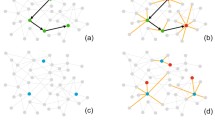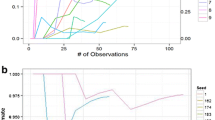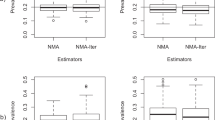Abstract
When a sampling frame for a given population cannot be defined, either because it requires expensive/time-consuming procedures or because it targets a stigmatized or illegal behavior that may compromise the identification of potential interviewees, traditional sampling methods cannot be used. Examples include “hidden populations” of special relevance for public health, such as men who have sex with men (MSM), sex workers and drug users. Since the late 1990s, a network-based method, called Respondent-Driven Sampling (RDS) has been used to assess such “hidden populations”.This paper simulates data from hidden populations, in order to assess the performance of prevalence estimators in different scenarios built after different combinations of social network structures and disease spreading patterns. The simulation models were parameterized using empirical data from a previous RDS study conducted on Brazilian MSM. Overall, RDS performed well, showing it is a valid strategy to assess hidden populations. However, the proper analysis of underlying network structures and patterns of disease spread should be emphasized as a source of potential estimate biases.
Access this chapter
Tax calculation will be finalised at checkout
Purchases are for personal use only
Preview
Unable to display preview. Download preview PDF.
Similar content being viewed by others
References
Baral, S., Sifakis, F., Cleghorn, F., Beyrer, C.: Elevated risk for hiv infection among men who have sex with men in low- and middle-income countries 2000-2006: a systematic review. PLoS Med. 4(12), 339 (2007), http://dx.doi.org/10.1371/journal.pmed.0040339 , doi:10.1371/journal.pmed.0040339
Boily, M.C., Bastos, F.I., Desai, K., Chesson, H., Aral, S.: Increasing prevalence of male homosexual partnerships and practices in britain 1990-2000: but why? AIDS 19(3), 352–4; author reply 354–5 (2005)
Gile, K.J., Handcock, M.S.: Respondent-driven sampling:: an assessment of current methodology. Sociological Methodology, 1467–9531 (2010)
Goel, S., Salganik, M.J.: Assessing respondent-driven sampling. Proc. Natl. Acad. Sci. USA 107(15), 6743–6747 (2010), http://dx.doi.org/10.1073/pnas.1000261107 , doi:10.1073/pnas.1000261107
Heckathorn, D.: Respondent-driven sampling: a new approach to the study of hidden populations. Social Problems 44, 174–199 (1997)
Heckathorn, D.: Respondent-driven sampling ii: deriving valid population estimates from chain-referral samples of hideen populations. Social Problems 49, 11–34 (2002)
Hosmer, D., Lemeshow, S.: Applied Logistic Regression. Jonh Wiley & Sons, Chichester (2000)
Malekinejad, M., Johnston, L.G., Kendall, C., Kerr, L.R.F.S., Rifkin, M.R., Rutherford, G.W.: Using respondent-driven sampling methodology for hiv biological and behavioral surveillance in international settings: a systematic review. AIDS Behav. 12(4 Suppl.), S105–S130 (2008), http://dx.doi.org/10.1007/s10461-008-9421-1
Malta, M., Magnanini, M.M.F., Mello, M.B., Pascom, A.R.P., Linhares, Y., Bastos, F.I.: Hiv prevalence among female sex workers, drug users and men who have sex with men in brazil: a systematic review and meta-analysis. BMC Public Health 10, 317 (2010), http://dx.doi.org/10.1186/1471-2458-10-317 , doi:10.1186/1471-2458-10-317
Mello, M., A, A.P., M, M.C., Tun, W., Júnior, A.B., Ilário, M., Reis, P., Salles, R., Westman, S., Díaz: Assessment of risk factors for hiv infection among men who have sex with men in the metropolitan area of campinas city, brazil, using respondent-driven sampling. Tech. rep., Population Council (2008)
Morris, M.: Network Epidemiology: A handbook for survey design and data collection. Okford University (2004)
Poon, A.F.Y., Brouwer, K.C., Strathdee, S.A., Firestone-Cruz, M., Lozada, R.M., Pond, S.L.K., Heckathorn, D.D., Frost, S.D.W.: Parsing social network survey data from hidden populations using stochastic context-free grammars. PLoS One 4(9), e6777 (2009), http://dx.doi.org/10.1371/journal.pone.0006777 , doi:10.1371/journal.pone.0006777
Romano, C.M., de Carvalho-Mello, I.M.V.G., Jamal, L.F., de Melo, F.L., Iamarino, A., Motoki, M., Pinho, J.R.R., Holmes, E.C., de Andrade Zanotto, P.M., V. G. D. N. Consortium: Social networks shape the transmission dynamics of hepatitis c virus. PLoS One 5(6), e11,170 (2010), http://dx.doi.org/10.1371/journal.pone.0011170 , doi:10.1371/journal.pone.0011170
Salganik, M., Heckathorn, D.: Sampling and estimation in hidden populations using respondent-driven sampling. Sociological Methodology 34, 193–239 (2004)
Salganik, M.J.: Variance estimation, design effects, and sample size calculations for respondent-driven sampling. J. Urban Health 83(6 suppl), 98–112 (2006), http://dx.doi.org/10.1007/s11524-006-9106-x , doi:10.1007/s11524-006-9106-x
R Development Core Team: R: A language and environment for statistical computing. R Foundation for Statistical Computing (2008)
Volz, E., Heckathorn, D.: Probability based estimation theory for respondent-driven sampling. Journal of Official Statistics 24, 79–97 (2008)
Strogatz, S.H.: Exploring complex networks. Nature 410(6825), 268–276 (2001), http://dx.doi.org/10.1038/35065725 , doi:10.1038/35065725.
Author information
Authors and Affiliations
Editor information
Editors and Affiliations
Rights and permissions
Copyright information
© 2011 Springer-Verlag Berlin Heidelberg
About this paper
Cite this paper
Albuquerque, E.M., Codeço, C.T., Bastos, F.I. (2011). Assessing Respondent-Driven Sampling in the Estimation of the Prevalence of Sexually Transmitted Infections (STIs) in Populations Structured in Complex Networks. In: da F. Costa, L., Evsukoff, A., Mangioni, G., Menezes, R. (eds) Complex Networks. Communications in Computer and Information Science, vol 116. Springer, Berlin, Heidelberg. https://doi.org/10.1007/978-3-642-25501-4_11
Download citation
DOI: https://doi.org/10.1007/978-3-642-25501-4_11
Publisher Name: Springer, Berlin, Heidelberg
Print ISBN: 978-3-642-25500-7
Online ISBN: 978-3-642-25501-4
eBook Packages: Computer ScienceComputer Science (R0)




